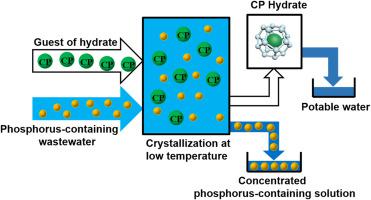Journal of Environmental Chemical Engineering ( IF 7.4 ) Pub Date : 2021-04-15 , DOI: 10.1016/j.jece.2021.105507 Yamei Yang , Rui Du , Changrui Shi , Jiafei Zhao , Yongchen Song , Lunxiang Zhang , Zheng Ling

|
With the rapid development of agriculture, controlling phosphorus emissions is a pressing challenge for preventing water eutrophication. A graphite-promoted cyclopentane (CP) hydrate-based desalination was proposed to remove K3PO4 from effluents. It was found via the in situ optical microscopy that the reaction temperature and the concentration of feeding K3PO4 solution significantly affect the morphologies and amount of the as-produced CP hydrate crystals. The lower reaction temperature produces more crystals with irregular shapes, while fewer crystals formed in K3PO4 solution with higher concentration. The reaction temperature, time and feeding concentration-dependent desalination and salt enrichment performances were studied. It was found that desalination efficiency linearly increases with the elevated reaction temperature ranging from -2 oC to 3 oC; however, water recovery declines with temperature. The temperature-dependent water recovery is due to the strong driving force for hydrate formation at low temperatures. The time-dependent water recovery shows a three-stage feature, including exponential growth, linear increase, and stable stages, owing to the interaction between the driving force of supercooling and the increasing K3PO4 concentration during the reaction processes. The desalination efficiency shows an inverted volcanic shape with the increased concentration of feeding K3PO4 solution. The pre-melting effect plays a critical role in improving desalination efficiency at high K3PO4 concentrations. A maximum desalination efficiency of 85.0% was reached for treating an artificial solution with salinity as high as 42452 mg/L. Both desalted water and concentrated phosphorus-containing solution can be recovered by this method, which is attractive for producing freshwater with potential for recovery of resources.
中文翻译:

环戊烷水合物对含磷废水的脱盐富集
随着农业的快速发展,控制磷的排放是防止水富营养化的紧迫挑战。提出了一种石墨促进的环戊烷(CP)水合物脱盐技术,以去除废水中的K 3 PO 4。通过原位光学显微镜发现,反应温度和进料K 3 PO 4溶液的浓度显着影响所生产的CP水合物晶体的形态和数量。较低的反应温度会产生更多具有不规则形状的晶体,而在K 3 PO 4中形成的晶体更少浓度较高的溶液。研究了反应温度,时间和进料浓度相关的脱盐和富盐性能。据发现,脱盐效率线性地升高的反应温度范围为-2增加ø C至3 ö ℃; 但是,水的回收率随温度下降。与温度有关的水回收率归因于在低温下形成水合物的强大驱动力。由于过冷的驱动力和增加的K 3 PO 4之间的相互作用,随时间变化的水回收率表现出三个阶段的特征,包括指数增长,线性增长和稳定阶段。 反应过程中的浓度。随着进料K 3 PO 4溶液浓度的增加,脱盐效率显示出反向的火山形状。在高K 3 PO 4浓度下,预熔融效果在提高脱盐效率中起关键作用。处理盐度高达42452 mg / L的人工溶液时,最大脱盐效率达到85.0%。淡水和浓缩的含磷溶液都可以通过这种方法进行回收,这对于产生具有资源回收潜力的淡水是有吸引力的。











































 京公网安备 11010802027423号
京公网安备 11010802027423号